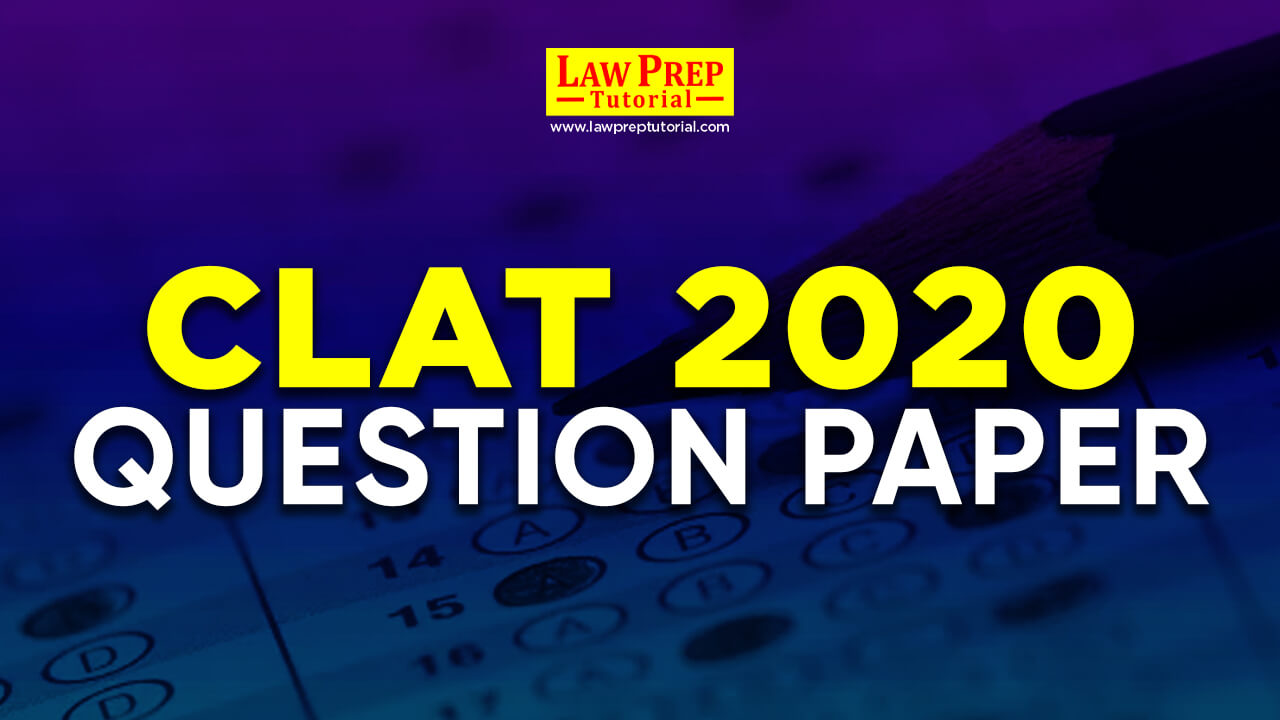Practicing with CLAT previous year papers is a cornerstone of effective exam preparation. The CLAT 2020 question paper provides important insights into the exam’s format and types of questions asked, serving as a crucial resource for any CLAT aspirant aiming to excel.
Here, we are sharing with you the CLAT 2020 question paper free PDF download to help you know the level of complexity and prepare accordingly.
For those looking to enhance their preparation further, consider enrolling in the best CLAT coaching in India to gain expert guidance and strategic advice personalized to your needs.
Upcoming CLAT Exams:
Highlights of CLAT 2020 Question Paper
| Aspect | Analysis |
| Overall Exam Difficulty | Moderate but Lengthy |
| Total Exam Duration | 2 hours (120 minutes) |
| Total Questions | 150 |
| Total Questions from the English Language | 30 |
| Total Questions from Current Affairs & General Knowledge | 36 |
| Total Questions from Legal Reasoning | 39 |
| Total Questions from Logical Reasoning | 30 |
| Total Questions from Quantitative Techniques | 15 |
| Total Marks | 150 |
| Marking Scheme | +1 for each correct answer, -0.25 for every incorrect answer |
Benefits of Practicing With CLAT 2020 Question Paper
Using the CLAT 2020 question paper effectively for preparation involves several strategic steps that can significantly enhance your readiness for the upcoming exam:
1. Familiarize Yourself with Exam Format
Start by thoroughly reviewing the CLAT 2020 question paper to understand the exam structure and the types of questions that were asked.
Pay attention to the number of questions in each section, the scoring system, and the time allotted. This will help you get a clear idea of what to expect and how to manage your time during the actual exam.
2. Identify Key Areas of Focus
Analyze the question paper to identify which topics were heavily emphasized. This will give you insights into the possible areas of focus for the exam you will be taking.
Prioritize these topics during your study sessions, as there is a good chance similar themes or topics will appear again.
3. Practice Under Exam Conditions
Simulate exam conditions at home by timing yourself while attempting the entire paper. This practice will help you build speed and accuracy, two crucial components for success in CLAT exam. It also helps in building stamina and focus for the actual exam duration.
4. Analyze Your Performance
After completing the paper, spend time reviewing your answers. Identify questions where you struggled or made mistakes and understand why you got them wrong. This review process is invaluable as it highlights your weaknesses and allows you to focus your studies more effectively.
5. Learn Time Management
By practicing with the CLAT 2020 question paper, you can better understand how to allocate time to different sections based on your strengths and weaknesses. Effective time management can often be the difference between a good and a great score.
6. Develop Answering Strategies
Use the question paper of CLAT 2020 to experiment with different answering strategies, such as tackling certain types of questions first or skipping questions that are too time-consuming.
This way, you can discover what works best for you and apply these strategies on exam day.
Must Know for Every CLAT Aspirant:
| CLAT Eligibility Criteria | CLAT Exam Pattern |
| CLAT Age Limit | CLAT Marking Scheme |
| How to Prepare for CLAT? | CLAT Preparation Books |
7. Use as a Benchmark
Regularly practicing with past papers allows you to measure your progress over time. By comparing your scores and the time taken to complete each section, you can gauge improvements and identify areas that need more attention.
8. Integrate With Coaching
If you’re enrolled in a CLAT coaching program, use the CLAT 2020 question paper as a tool to discuss strategies and problem-solving techniques with your mentors.
Coaching provides personalized feedback and additional tricks that can be particularly effective for the types of questions seen in the paper.
CLAT 2020 Question Paper PDF (With Solution)
Download the CLAT 2020 question paper with answer key PDF here to access a valuable resource for your exam preparation:
Important CLAT Questions for Practice:
| CLAT Legal Reasoning Questions | CLAT Logical Reasoning Questions |
| CLAT English Questions | CLAT GK Questions |
Analysis of CLAT 2020 Paper
There have been certain ups and downs in each section of CLAT 2020 question paper. The detailed section-wise analysis is given below:
English Language
The difficulty level of this section in the paper was fairly moderate. The section had a total of six reading comprehensions, out of which three were story-based and consisted of word meaning, synonyms, and grammatical and inferential questions. The passages were lengthy but easy to comprehend.
Highlights
- This section comprised 30 questions with 6 passages.
- The comprehension passages were based on Climate Change, Boys Locker Room Controversy, and Virtual Reality.
- The story-based questions included excerpts from ‘The Cat’ by Mary Freeman, ‘The Night Came Slowly’ by Kate Chopin and ‘The Case for the Defence by ‘Graham Greene’.
Current Affairs and General Knowledge
The difficulty level of this examination laid between moderate to slightly difficult. The questions required specific knowledge of the events and reasons affecting it. The questions were formed from topics like Rafale Deal, Atma Nirbhar Bharat Scheme, National Education Policy, SAARC Meeting, UN General Assembly, RBI Policy, Lipulekh Pass (Indo-Nepal) and UAE and Israel Relations.
Highlights
- This section comprised 36 questions with 7 passages.
- The candidates who had a decent preparation of current affairs sections or those who kept a keen eye on the newspapers did fairly well in this section.
Legal Reasoning
This section was a new addition to the CLAT syllabus. Earlier the paper had a Legal Aptitude section which was replaced by the latter. This section was fairly difficult,, and the candidates had to put in a lot of time to read in order to answer the questions.
Highlights
- This section comprised 39 questions with 8 passages.
- The questions were formed from current topics which included Vizag Gas Leak, COVID 19, Lynching in Palghar District, Article 20 (1): Ex post facto laws, Arnab Goswami vs Union of India and Common intention, and some general topics like issue of obscenity, and the principle of natural justice.
- No knowledge-based questions were asked in this section; they were mostly generic.
Logical Reasoning
This section was fairly easy but very time consuming. It consisted of passages which took a lot of time to read and solve. There were only two questions based on analytical reasoning.
Highlights
- This section consisted of 30 questions.
- 28 questions were from Critical Reasoning while only 2 were from Analytical Reasoning.
- The questions in the Critical Reasoning were formed from the anti-alcohol movement, Class 12th CBSE result, work from home during corona pandemic, online classes, and social journalism.
- The two Analytical Reasoning questions were based on matrix puzzle and coding-decoding.
Quantitative Techniques
This section too was fairly easy as all the questions involved very basic calculations. A graph-based question was asked in the paper. 5 questions from the section were considered to be incorrect.
- This section had 15 questions under 3 sets.
- Each set had 5 questions based on Bar Graph, Table DI, Geometry/Mensuration.
- Two questions from a set were reported to be incorrect.
Wrapping Up:
Effectively using the CLAT 2020 question paper PDF can enhance your exam preparation. By practicing with past papers, you gain a better understanding of the CLAT exam pattern and improve your ability to manage time and stress.
To further bolster your preparation, join the best CLAT coaching and regularly take mock tests. These resources provide comprehensive training and real-time feedback to refine your strategy and boost your confidence, ensuring you are well-prepared to achieve your best score in the CLAT exam.
More Previous Year Papers of CLAT
Below are the PDFs of previous year question papers of CLAT with answers, which you can download for FREE:
| Year | PDF Link |
| CLAT 2025 Question Paper | Click to download |
| CLAT 2024 Question Paper | Click to download |
| CLAT 2023 Question Paper | Click to download |
| CLAT 2022 Question Paper | Click to download |
| CLAT 2021 Question Paper | Click to download |
| CLAT 2020 Question Paper | Click to download |
| CLAT 2019 Question Paper | Click to download |
| CLAT 2018 Question Paper | Click to download |
| CLAT 2017 Question Paper | Click to download |
| CLAT 2016 Question Paper | Click to download |
| CLAT 2015 Question Paper | Click to download |
| CLAT 2014 Question Paper | Click to download |
| CLAT 2013 Question Paper | Click to download |
| CLAT 2012 Question Paper | Click to download |
| CLAT 2011 Question Paper | Click to download |
| CLAT 2010 Question Paper | Click to download |
| CLAT 2009 Question Paper | Click to download |
| CLAT 2008 Question Paper | Click to download |
Law Colleges Information Related to CLAT:
| List of NLUs in India | CLAT Colleges in India |
| CLAT Colleges in Delhi | CLAT Colleges in Rajasthan |
| Top 5 NLUs in India | NLSIU Bangalore Seats |
Important Resources After CLAT Exam:
All the Best and Work Hard!



